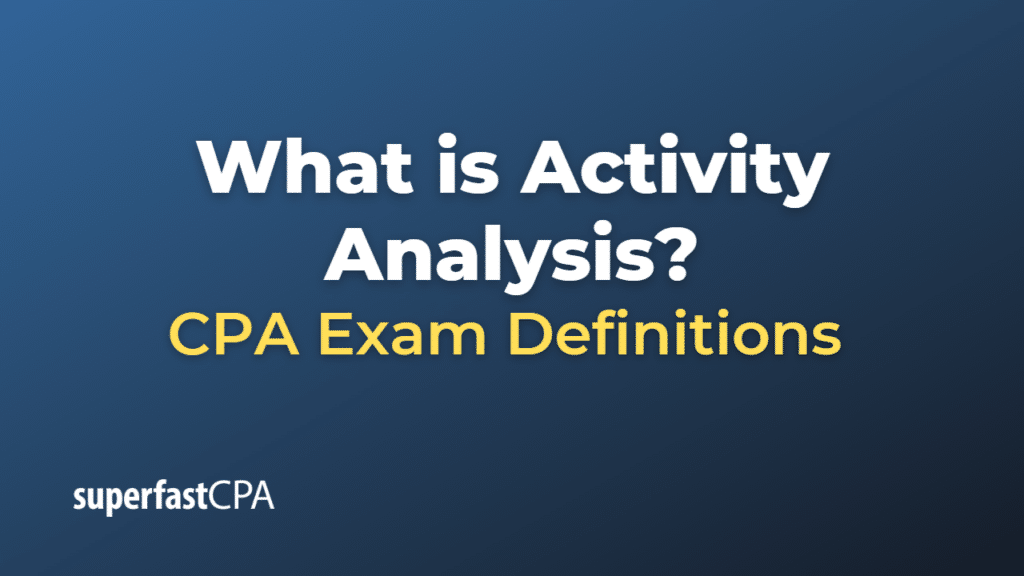Activity Analysis
Activity analysis is a method used in management accounting and activity-based costing (ABC) to identify, analyze, and understand the various tasks, processes, and activities carried out within an organization. The primary goal of activity analysis is to determine the resources consumed by each activity and allocate costs to products or services based on the level of resources they consume.
Activity analysis allows organizations to:
- Identify the activities and processes involved in producing a product or service.
- Understand the relationships between different activities and how they contribute to the overall production process.
- Determine the resources (such as labor, materials, and overhead) consumed by each activity.
- Allocate costs to products or services based on the level of resources consumed by each activity.
- Identify inefficient or non-value-adding activities and opportunities for improvement or cost reduction.
- Make informed decisions about pricing, product mix, process improvements, and resource allocation.
By analyzing activities and their associated costs, organizations can gain insights into their operations, identify inefficiencies, and make data-driven decisions to improve performance and profitability. Activity analysis is particularly useful for organizations with complex production processes, multiple products, or services and a significant amount of indirect costs.
Example of an Activity Analysis
let’s consider a fictional company called “XYZ Electronics” that manufactures two types of smartphones: Model A and Model B. XYZ Electronics uses Activity-Based Costing (ABC) and wants to conduct an activity analysis to better understand its costs and improve profitability.
Step 1: Identify Activities XYZ Electronics identifies the following activities involved in its production process:
- Purchasing raw materials
- Assembling smartphones
- Quality control testing
- Packaging
- Shipping
Step 2: Determine Resource Consumption The company determines the resources consumed by each activity:
- Purchasing raw materials: 2 employees, $50,000/year in salaries
- Assembling smartphones: 10 employees, $400,000/year in salaries
- Quality control testing: 3 employees, $120,000/year in salaries
- Packaging: 2 employees, $60,000/year in salaries
- Shipping: 1 employee, $30,000/year in salaries
Step 3: Allocate Costs to Products XYZ Electronics decides to allocate the costs to Model A and Model B based on the level of resources consumed by each activity:
- Purchasing raw materials: Model A uses 60% of the raw materials, while Model B uses 40%.
- Assembling smartphones: Model A requires 50% of the assembly time, while Model B requires the other 50%.
- Quality control testing: Model A accounts for 70% of the testing time, while Model B accounts for 30%.
- Packaging: Model A requires 40% of the packaging resources, while Model B requires 60%.
- Shipping: Model A accounts for 45% of the shipping resources, while Model B accounts for 55%.
Step 4: Calculate Activity Costs for Each Product Using the allocated percentages, XYZ Electronics calculates the costs associated with each activity for Model A and Model B:
Model A:
- Purchasing raw materials: $50,000 * 0.60 = $30,000
- Assembling smartphones: $400,000 * 0.50 = $200,000
- Quality control testing: $120,000 * 0.70 = $84,000
- Packaging: $60,000 * 0.40 = $24,000
- Shipping: $30,000 * 0.45 = $13,500 Total Cost: $351,500
Model B:
- Purchasing raw materials: $50,000 * 0.40 = $20,000
- Assembling smartphones: $400,000 * 0.50 = $200,000
- Quality control testing: $120,000 * 0.30 = $36,000
- Packaging: $60,000 * 0.60 = $36,000
- Shipping: $30,000 * 0.55 = $16,500 Total Cost: $308,500
Step 5: Identify Opportunities for Improvement Based on the activity analysis, XYZ Electronics can now identify areas for potential cost reduction or process improvements. For example, the company may decide to reduce the time spent on quality control testing for Model A, as it consumes 70% of the testing resources. Alternatively, the company may explore ways to reduce the packaging costs for Model B, which requires 60% of the packaging resources.
By conducting an activity analysis, XYZ Electronics can gain insights into its production process, identify inefficiencies, and make data-driven decisions to improve performance and profitability.













